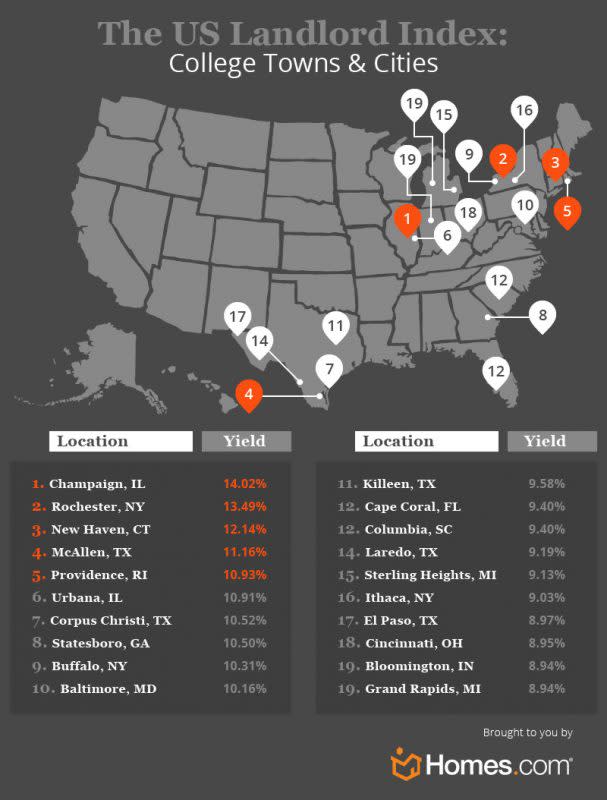The best and worst places to invest in real estate in college towns
If you’re thinking of investing in real estate, buying in a college town offers a lot of perks, along with a substantial and steady stream of potential tenants. While there’s a lot to consider when making a real estate investment, your ROI, or return on investment, should be at the top of your list.
Your property’s ROI is the percentage of invested money you get back after you subtract your associated home costs, like mortgage, taxes and maintenance. When looking at college towns, the average cost of a home is $175,000, and monthly rent for a 3-bedroom is $1,881, according to a report by Homes.com. Using that information, the report ranked the ROI for 147 college towns.
Champaign, Ill., had the highest ROI, at 14.2%. While it’s close to Chicago, housing prices are much lower, making it an appealing choice for investors and a popular location for renters. Rounding out the top five were Rochester, N.Y. (13.49%); New Haven, Conn. (12.14%); McAllen, Texas (11.16%); and Providence, R.I. (10.93%).
The college town with the lowest ROI is Scottsdale, Ariz., (1.92%), due to low rents, meaning investors are just breaking even. Other cities with low ROIs were Boston (2.20%); Princeton, N.J.; 2.92%; New York (3.02%); and Seattle (3.05%).

“The average investor investing in real estate is interested in anything over 5% on ROI,” says Grant Simmons of Homes.com. College towns with affordable housing and low cost of living were more appealing than cities with high real estate costs, like New York and Boston, where you’ll face competitive markets.
It’s also important for investors to consider vacancy rates in their city. The average vacancy rates for rental properties is 7%, which means the property is vacant approximately 1 month out of the year. Investors would not only miss out on this rent, but they’d be paying associated property costs without money coming in.
One way to increase get your listing more attention could be to work with nearby colleges: ask about getting your rental as a recommended property by the student housing department for off-campus living, in accordance with their policies.
Other considerations for investing in a college town are location, location, location, says Simmons. Consider: how far is your property from the college or a major city, and what are the transportation options?
Taking on an investment property could be a risk, especially when your tenants are students who might not be as responsible with the property. Plus, if you don’t live in the area, you’ll have to consider hiring a management company to handle the property, which can account for 5%-10% of your rental cost each month.
Considering your ROI before you buy will determine if investing in a college town is the best financial decision for you.
WATCH MORE
The most accurate way to calculate how much home you can afford

 Yahoo Finance
Yahoo Finance 